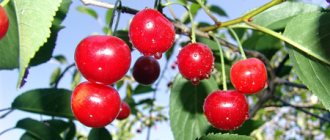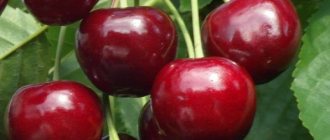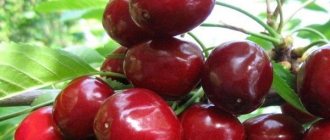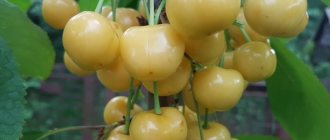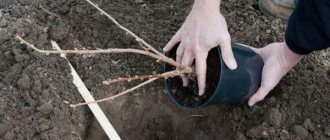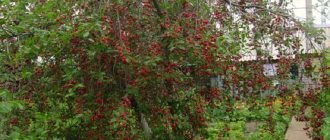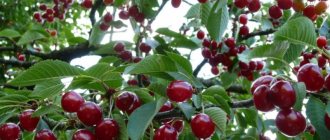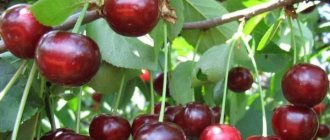Photo and description of the Leningradskaya black cherry variety
The variety was obtained by breeders from the Pavlovsk experimental station VIR, located in St. Petersburg. The institution is engaged in the study of ornamental shrubs, vegetables, fruits and berries. When breeding varieties, attention is paid to winter hardiness and unpretentiousness of plants.
Mature tree height
The tree reaches a height of 3-4 m. The density and foliage are average. The crown is spreading and wide.
Flowering and ripening period
Flowering occurs in the middle period - the second ten days of May. In southern areas, the fruits are harvested at the end of June. In the northern regions, fruiting begins in mid or late July. The ripening of cherries is extended over time and takes several weeks. At the same time, it does not crumble and hangs on the branches for a long time, until the beginning of autumn. The berries are easily torn from the stalk.
Productivity
Before planting, it is important to know what year Leningradskaya black cherries bear fruit. The first harvest is harvested in 3-4 years. One tree bears 30-40 kg of fruit. Cherry has a mass of 3-3.5 g and is round in shape. The skin is dark burgundy in color and becomes almost black as it ripens. The pulp is tender, soft fibrous. The taste is sweet, spicy with a slight sourness. Taste qualities are rated 4.2 points. The medium bone separates well from the pulp.
Transportability
The fruits tolerate transportation and storage in the refrigerator well. The purpose of the variety is universal: fresh consumption, preparation of desserts, baking fillings, homemade preparations.
Drought resistance
The resistance of Leningradskaya dessert cherries to drought is average. For irrigation, a standard scheme is suitable, which takes into account the characteristics of the crop.
Frost resistance
The variety has increased winter hardiness. Wood and flower buds tolerate winter cold well. For additional protection from the cold, preparatory measures are carried out in the fall.
Advantages and disadvantages
The characteristics of the Leningradskaya Black cherry, taking into account the growing regions, are very good. It has advantages and disadvantages, but the former clearly outweigh.
| Advantages | Flaws |
|
|
How to plant Leningradskaya black cherries
When planting the Leningradskaya Chernaya variety, a number of factors are taken into account: soil condition, illumination of the site, climatic conditions in the region, quality of the seedling.
How to choose a seedling
For seedlings, contact nurseries or trusted centers. When choosing a plant, evaluate the condition of the shoots and root system. They should be free of mold, cracks, lichen and other defects. One- and two-year-old seedlings with a height of 80-120 cm take root best. From the assortment, choose cherries with a pronounced conductor and 3-4 shoots. If the roots are a little dry, the tree can be saved. The root system is kept in clean water for 5-8 hours.
Planting dates and scheme
The timing for planting the Leningradskaya Chernaya variety depends on weather conditions. First, they wait for the autumn leaves to fall. If the weather is stable without cold snaps, then work begins. In 2-3 weeks the plant will have time to adapt and successfully overwinter. If frosts are expected, planting is postponed to spring. The seedlings are buried on the site, and sawdust and peat are poured on top for insulation.
Advice! The ideal place for cherries is sunny, sheltered from the wind, with fertile soil.
The crop is not planted in lowlands, as well as in peat bogs, marshy, sandy and clayey areas. Cherry prefers sandy and loamy soils that allow moisture and air to pass through well. The tree is placed on a hill and flat area, on the south or west side. The seedling is removed 5 m from large trees. Closer proximity to cherries and other varieties of cherries is allowed.
Pit preparation
Regardless of the chosen planting time, the pit for the crop is prepared in advance. Within 3-4 weeks, the soil shrinks, which damages the seedling. If the work is planned in the spring, then the foundation pit is prepared in the fall. If the soil on the site does not allow moisture to pass through well, then a drainage layer of crushed stone or expanded clay is installed at the bottom of the pit. Coarse river sand is added to the substrate.
Cherry planting algorithm:
- Dig a hole with a diameter of 0.7x0.7 m to a depth of 0.6 m.
- The pit is half filled with substrate: chernozem, humus, 180 g of superphosphate and 90 g of potassium salt.
- Then pour out 2 buckets of water and leave the hole for several weeks.
- Before planting cherries, fertile soil is poured in the form of a small hill.
- The plant is planted on a hill, the roots are sprinkled with black soil.
- The soil is well compacted and 2 buckets of water are poured under the seedling.
Landing Features
The best yield and quality of fruits can be ensured by the correct choice of seedling and planting site.
Recommended disembarkation times
Cherry is a heat-loving crop, and it is better to plant seedlings in the spring, before the buds swell, so that during the growing season, which lasts 8 months, the tree has time to take root and get stronger.
But in regions with mild winters, autumn planting is also possible, but the maximum permissible period is mid-October. At this time there should be no frosts or frozen soil, and the seedling should be provided with additional protection from winter cold.
Choosing a suitable location
Recommended reading
How to distinguish cherries from sweet cherries? Even a winter-hardy variety should be planted in an area protected from northern winds by trees, fences or buildings.
A slight slope towards the south or southwest is allowed. You can raise the soil by half a meter by making a small hill or embankment.
The place should be well lit throughout the day and sunny, otherwise fruiting will be located on the outer part of the crown.
Areas with close groundwater (1.5–2 m), stagnation of melt or rainwater in low-lying areas and excess soil moisture should be excluded when choosing a location for cherries. Cherries grow best on loam or sandy loam, well-aerated soils.
What can and cannot be planted next to cherries?
When planning the layout of the future garden, you should remember that pome and stone fruits do not like being next to each other, so it is advisable to place such crops no closer than 4–5 m from each other. It is better to plant crops in groups, avoiding mixed plantings.
In addition, cherries require a large feeding area (up to 4 m2). This distance must be maintained between trees. It must be taken into account that each tree will need sunlight, moisture, and nutrients.
Since the variety is self-sterile, it is necessary to plant several pollinating varieties nearby - it is good if 2-3 such trees grow nearby. Thickening of plantings should be avoided, as otherwise the trees will stretch upward, which will complicate harvesting.
Did you know? Cherry flowers are rich in pollen - from 1 hectare of cherry orchard, bees can collect up to 35 kg of pollen.
- Cherries, rowan berries and other cherries can grow next to the cherry tree. A good neighbor will be the black elderberry, which will also serve as protection for the cherries from aphids.
- Pome fruits (apple, pear), plums, sea buckthorn, black and red currants, and viburnum are considered bad neighbors. You should not plant nightshade crops and all types of peppers under cherries.
At the same time, the crown of the cherry tree is sparse, and there is enough sunlight and moisture under it when it rains, so honey-bearing flowers can be planted at the base to attract pollinating insects.
Selection and preparation of planting material
It is advisable to purchase a seedling from a nursery with a good reputation, so as not to be mistaken with the variety and quality of planting material.
When choosing, the following rules should be observed:
- the variety must be zoned;
- the label on the seedling must contain information about the variety and time of grafting;
- conditions on the site (soil, groundwater, lighting) must correspond to the conditions for cultivating cherries;
- It is better to buy planting material in the spring, before the buds open, or in the fall, after the leaves on the seedling fall off and the end of sap flow;
- seedlings must be annual (0.8–1 m) without branches or biennial (up to 1.5 m) with 2–3 branches and one conductor;
- the bark, branches and trunk should not have any damage or signs of disease;
- seedlings purchased in the fall can be buried on the site, placed in a trench (35–40 cm) at an angle of 45° with the crown to the south;
- leaves from the branches of the seedling must be removed to prevent its dehydration;
- the rhizome should be moderately moist, with well-developed and intact roots;
- the thickness of the lower part of the trunk is 1.5–2.5 cm; there should be a noticeable grafting point at a height of 15–20 cm.
Important! Cherry trees do not tolerate mechanical stress and damage well, so it is advisable to form a crown in the first 2–3 years and not injure the tree in the future.
Planting scheme
It is better to select and prepare a place for planting a seedling in the fall by digging a planting hole twice the size of the root system. Usually a depth of 60–70 cm and a diameter of 80–90 cm is sufficient. Place 2 buckets of humus mixed with a small amount of soil at the bottom. In this form, the pit will overwinter.
On the eve of the planned planting, pour the dug hole well with water and dig a stake (1.0–1.5 m) into the center, to which the seedling will be tied. The day before planting, the roots should be soaked in a root formation stimulator according to the instructions or in water, removing dried and damaged roots.
The seedling is placed in a hole, carefully straightening the roots, and sprinkled with earth. Lightly compact for better adhesion of roots to soil, water and mulch. The root collar should be 5–8 cm above the ground level, taking into account the subsidence of the earth after watering. The vaccination site should face south.
The distance between seedlings is maintained at 3–4 m so that in the future the trees do not shade each other. It should be remembered that the diameter of the cherry crown is usually 3 m with a slight discrepancy depending on the variety. The exception is columnar varieties.
Care for Leningradskaya black cherries
Garden care helps ensure regular fruiting of cherries. The tree needs feeding, watering and pruning.
Feeding and watering
The first feeding is carried out in the spring when the leaves bloom. Mullein infusion is poured into the tree trunk circle. Instead of natural fertilizer, a solution of urea or ammonium nitrate is also used. When flowering, superphosphate and potassium salt are added. 35 g of each substance is embedded in the soil or added to water before watering. Frequent moisturizing will only harm the cherries. The tree is watered during the flowering period and at the beginning of fruiting, if there is a drought. The water requirement is 10-12 buckets.
Weeding and loosening
After precipitation or watering, the soil is loosened to avoid stagnation of moisture. The tree trunk circle is regularly cleared of weeds. Loosening helps cherry roots better absorb moisture and minerals. To do this, use a hoe, cultivator or other garden tool.
Crown formation
A tiered, sparse crown shape is ideal for cherries. Its formation takes 5-6 years. By pruning, access of sunlight to fruits and leaves is ensured, productivity increases, and the risk of developing diseases is reduced. For each tier, 3 powerful shoots are left. The remaining branches are cut off. A certain distance is maintained between the tiers - about 0.5 m. Dry, frozen and diseased branches are removed every year.
Diseases and pests
Like all green spaces, Leningradskaya cherries can be affected by diseases and pests. You can avoid the occurrence of misfortunes by promptly removing foliage from the tree trunk, thinning the crown, and spraying trees for prevention with fungicides and insecticides.
Clusterosporiasis
The second name of the disease is perforated spotting. Infection occurs in the spring: the mycelium of the fungus, overwintering in plant debris, easily penetrates through cracks in the stem and shoots of the cherry tree.
To prevent fungal disease, you need to remove foliage from the tree trunk for the winter and treat the crown and soil with a fungicide.
Moniliosis
The fungus attacks flowers, fruits and leaves, which prematurely wither and fall off. Diseased parts of the tree are cut out and the crown is sprayed with Bordeaux mixture. For prevention, plant debris is removed, and Nitrafen is used in early spring.
Aphid
The insect feeds on the sap of the plant, weakening and inhibiting it. The quality and quantity of the harvest decreases. Aphids are eliminated by spraying trees with Confidor. To prevent the appearance of insects, the soil around the trunk is dug up and the crown is sprayed with an insecticide.
cherry fly
Its larvae damage flowers and then fruits. The pupae overwinter in the tree trunk at a depth of 4-5 centimeters. Therefore, in early spring, the area under the cherry tree crown is dug up and pests are selected manually. The fly and larvae are sprayed with Actellik.
False tinder
The fungus appears on the trunk of the cherry tree. Pathogenic microorganisms settle in cracks and wounds, forming a yellow and brown growth. To rid a tree of a disease, you need to strip the trunk to the healthy part, treat it with a copper-containing preparation, and cover it with garden varnish.
Cylindrosporiosis
The second name of the disease is white rust, which is caused by a fungus. Cankers appear on the branches, from which gum flows. Trees quickly weaken and may not survive the frosty winter. At the first signs of disease, wounds and cracks need to be cleaned and disinfected.
Phyllosticosis
Brown spot affects cherry leaves, which soon dry out and fall off. To prevent the disease, remove foliage from the tree trunk and treat the trees several times a season with a solution of copper sulfate or Bordeaux mixture.
leaf roller
The leaf roller caterpillar causes damage to plantings. You can tell that a tree has been infected by this pest by the presence of cobwebs. The caterpillar weaves around a cherry leaf, then eats it. To prevent the appearance of the pest, trees are sprayed with an insecticide in early spring.
Pollinators of Leningradskaya black cherry
Cherry is a self-fertile crop that produces a harvest in the presence of pollinators. This includes any varieties that bloom at the same time. 3-4 m are left between them. If there is little free space on the site, then different types of cherries are grafted onto one tree. Other conditions are also necessary for the appearance of ovaries: stable warm weather, absence of rain and drought.
The best pollinators for mid-early Leningrad black cherries:
• Tyutchevka. Medium-sized variety with a spherical crown shape. The fruits are burgundy, weighing up to 7.5 g. The pulp is dense and juicy. The taste is sweet, assessed by experts at 4.9 points. Fruiting occurs in the 5th year. Resistance to coccomycosis is average. Universal application. • Bryanochka. Cherry with large dark red fruits. The pulp is dense and sweet, taste rating – 5 points. Flowers are susceptible to spring frosts. Resistance to coccomycosis is increased, resistance to moniliosis is average. • Revna. Medium-sized variety with a pyramidal crown shape. The flesh is burgundy, almost black. The taste is sweet, rated 4.9 points. The start of fruiting occurs in the 5th year. The Revna variety brings a stable high yield. The fruits are transportable and do not crack. • Seda. A tall tree with a spherical crown. Fruits weighing 5.5 g are almost black, smooth and round. The red flesh is tender and juicy. Medium winter hardiness variety. • Teremoshka. Sweet cherries with large fruits with a dessert taste. The tree has compact dimensions. Winter hardiness is high. The fruits are well transported and are not subject to cracking. Sweet cherries are distinguished by high immunity to diseases and high and stable yields.
Harvest rationing
Every gardener who has grown young trees knows how eager he is to see the fruits of a new variety. But there is no need to rush into this. The main task is to get a strong, healthy tree. And then enjoy its sweet, cool fruits to your heart’s content.
If the tree you planted blooms in the first year, it is better to remove all the buds. Can't you raise your hand? Well, if it is strong and develops well, you can leave about a fifth of the resulting flowers. There is no guarantee that at least one berry will ripen, but there is still a chance.
Subsequently, in the spring, if possible, half of the formed ovaries (not flowers!) are cut off. This will allow you to get large and tasty fruits. And the load on the tree will be less. Typically, cherries in the middle zone bear fruit within a year. If you normalize the number of fruits, then next year it can produce a decent harvest.
Harvesting and storage
The maturation of Leningrad black does not occur simultaneously. Ripe berries are removed from the same tree 2–3 times
Harvesting must be done carefully so as not to damage the fruits. Start harvesting from the lower branches, gradually moving to the top of the crown
For high places you will need ladders.
Did you know? Sweet cherry is an ancient form of cherry, but in the Middle Ages they were considered a single crop, cerasus, adding the term “sweet” to the cherry and “sour” to the cherry. Cherries were also called “bird cherries” for the love of birds for this berry.
Morning hours are most favorable for picking, as the fruits have better pulp density. For collection, it is advisable to use containers with a soft inner surface. Soft cherries cannot be stored for long periods of time, but if picked slightly unripe in a cool place (+6...+7°C) they can last for 2-3 weeks and be transported.
If your region does not have favorable climate and soil characteristics, then Leningradskaya black cherries are an excellent choice for the garden. Cherries will allow you to enjoy early berries and provide your family with vitamins.
Pollinators and care
Gardeners consider the disadvantage to be the need to have a pollinator variety nearby. Leningradskaya black is self-sterile, and for fruiting it is necessary to provide for the presence of such varieties as Bryanochka, Veda, Iput, Revna, Tyutchevka nearby.
The branches of the tree are quite fragile, so when there is a bountiful harvest, it is recommended to install supports under them so that they do not break off. The plants are moisture-loving, however, in the climatic conditions for which they were bred, this is not a big problem. According to reviews, the variety is considered winter-hardy. It also successfully resists the causative agents of the main diseases of cherry trees: monilliosis and coccomycosis.
The easiest way to get Leningrad black is to buy a grafted one- or two-year-old seedling. Experienced gardeners recommend purchasing zoned plants with an open root system for spring or autumn planting. More hardy planting material are specimens with a closed root; they can be transplanted almost at any time.
The soil form prefers light, breathable, without stagnant moisture and acidic reaction. The trees are planted in a prepared, spacious hole filled with fertilizers, which has previously stood. When planting, pour out two buckets of water. Don’t forget to tie it to a peg for stability.
Subsequently, they are often inspected and treated for pests and diseases. Watering is carried out weekly if necessary in the first year, and in subsequent years the frequency decreases. Mature trees are dug along the projection of the crown, making a shallow groove where the suction roots are located. Both water and dissolved nutrients are absorbed by them.
